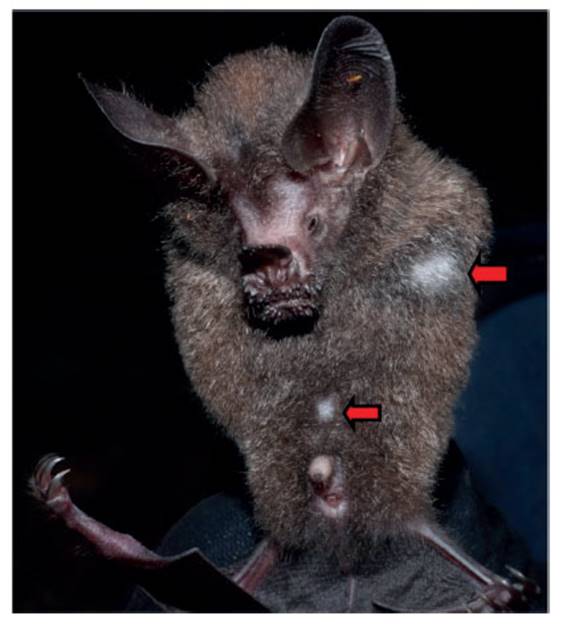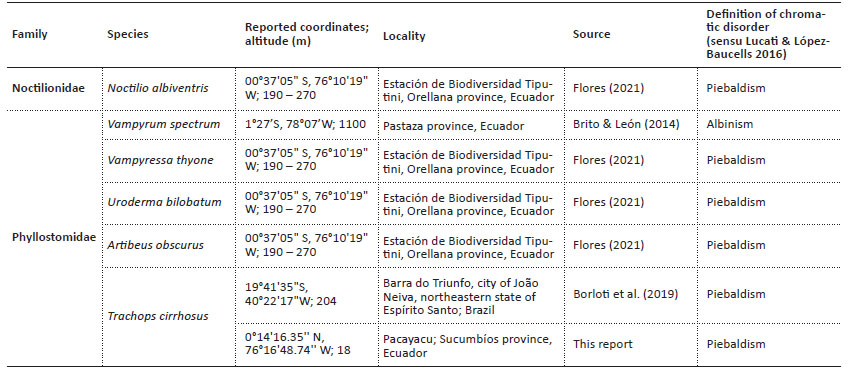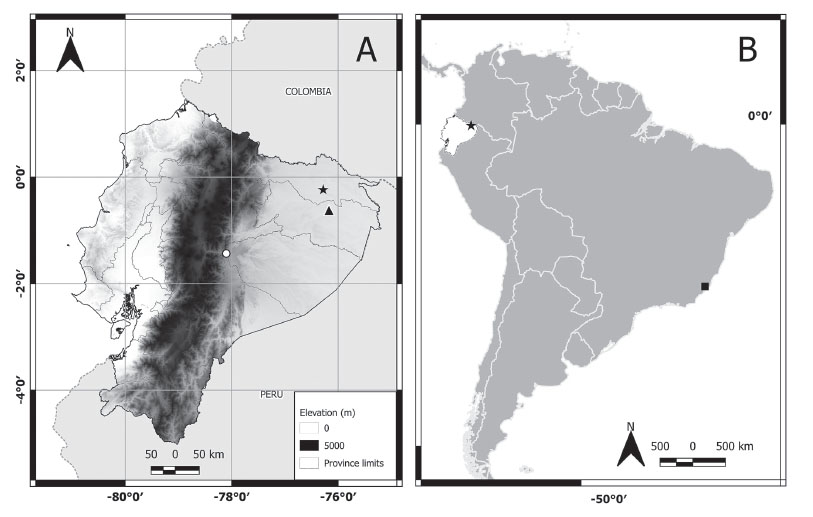Introduction
Chromatic disorders in vertebrates are abnormal coloration of the skin and integuments caused by the excess or absence of pigmentation in the body (Uieda 2000, Lucati & López-Baucells 2016). These disorders are attributed to the expression of mutant alleles (Bensch et al. 2000, Moller et al. 2013), or the production of the tyrosinase enzyme, that produces the melanin in vertebrates (Lamoreux et al. 2010). These disorders include hyperpigmentation and hypopigmentation. The hyperpigmentation (e.g. melanism), refers to a marked dark or brown pigmentation whereas the hypopigmentation (e.g. albinism, piebaldism) when the body present a total loss of color or white spots in skin or hair (Lucati & López-Baucell 2016).
Hypopigmentation disorders are recognized easily, but their classification has been confusing. Due to this, Lucati & López-Baucells (2016) proposed the use of standard terms for chromatic disorders like albinism (total absence of melanin in the skin, white hairs, pale skin and red eyes), leucism (white or whitish hairs, pale skin, normal colored eyes), piebaldism (white or whitish patches on skin or hair, normal colored eyes), and hypomelanism (presents pale brown, gold, yellowish, reddish colors in the skin and hair, normal colored eyes); this classification was based on hereditary causes and phenotypic characteristics of hypopigmentation cases in bats.
These hypopigmentary disorders have been reported in several bat species of the Molossidae, Mormoopidae, Phyllostomidae, and Vespertilionidae families in many Neotropical countries such as Argentina, Brazil, Colombia, Costa Rica, Guatemala, Mexico, Peru, Puerto Rico and Venezuela(Geiger & Pacheco 2006, Ruelas et al. 2016, Medina & López 2010, Marin-Vasquez et al. 2010, Idoeta et al. 2011, López-Wilchis & León 2012, Rocha et al. 2013, Olarte-González et al. 2014, Tello et al. 2014, Trujillo & Barahona 2014, Romano et al. 2015, Mello-Torres & Salazar-Candelle 2016, Zalapa et al. 2016, Mejía-Quintanilla et al. 2017, Hernández-Aguilar & Santos-Moreno 2018, Escobar-Anleu & Mora 2018, Reis et al. 2019, Borloti et al. 2019, Rivero-Castro et al. 2020, Pereira et al. 2022, Santos-Moreno & Hernández-Aguilar 2022). The manifestation of these disorders is unusual in wild mammals (Abreu et al. 2013), and various authors associate it to ecological and genetic factors, the isolation of populations and inbreeding, or exposure to chemical substances or radiation (Bensch et al. 2000, Moller et al. 2013, Beninato et al. 2020).
In Ecuador, hypopigmentary disorders in bats have been recorded in nine species of the families Phyllostomidae, Molossidae, and Noctilionidae from the western coastal provinces of Esmeraldas, Guayas, Los Ríos (Boada & Tirira 2010, Fernández et al. 2017, Salas et al. 2021) and in the eastern or Amazon region, in the provinces of Orellana and Pastaza (Brito & León 2014, Flores 2021). In this note, we report a new case of hypopigmentation disorder in an individual of Trachops cirrhosus caught in an intervened habitat located northeast of Ecuador in the Amazon region.
Material and methods
During 30 days of fieldwork, from February to March 2022, the Company PROCAPCON CONSULTORES CIA. LTDA. conducted a monitoring of mammals in Putumayo, province of Sucumbíos, northeast of Ecuador, through scientific authorization N°030-2021 RVS-FLO/FAU/DZ9/MAATE. The study area corresponds to the lowland evergreen forest of the Aguarico Putumayo-Caquetá and presents a semi-deciduous ecosystem with wooded areas and flood zones; this zone presents an average temperature of 20 °C and annual rainfall is 3075 mm of rain, its humidity is 81% (MAE 2013).
For bat surveys, the field team established nine sampling points in five communities in the municipality of Putumayo: Espíritu Noteno, Comuna Tigre playa, Alma Lojana, Ciudad de Quito and La Calumeña. In every point, 10 mist nets (12 m long x 3 m wide) were placed, for three consecutive nights and remained open for four hours from 18:00.
Each captured individual was handled in accordance with the ethical considerations of the American Society of Mammalogy (Sikes et al. 2016) and five external measurements were taken (mm): Forearm length (FA), tail length (T), head-body length (HB), foot length (F), and ear length (E). The age class (juvenile, subadult, or adult) was determined by observing the epiphyseal-diaphyseal fusion (Brunet-Rossinni & Wilkinson 2009), in addition to sex and reproductive status (Racey 2009). Additionally, the bats were marked in his left forearm with red nail polish (Rodríguez-Posada & Santa-Sepúlveda 2013). All individuals were photographed, georeferenced, and released.
Bats were identified to a specific level using identification guides available (Tirira 2017; Díaz et al. 2016). Additionally, the individual of Trachops cirrhosus was identified based on the following external characteristics: dense brown dorsal hair, large round ears, lance-shaped nasal leaf, chin and lips with numerous conical wart-like protuberances, being an exclusive characteristic of this species described in Cramer et al. (2001). Finally, we searched for and mapped georeferenced reports of chromatic disorders of bats from Ecuadorian Amazon, and T. cirrhosus in the Neotropics.
Results
During this work, 177 bats were captured, corresponding to 23 species, all belonging to the Phyllostomidae family. Among them, six individuals of Trachops cirrohosus was caught, include one subadult male that exhibited two whitish spots on the ventral region: on the left side of the pectoral region, and another on the left level of the abdomen (Fig. 1). The other individuals 5 adult individuals of this species (3 males and 2 female) presented normal coloration.

Figure 1 A subadult male specimen of Trachops cirrhosus with piebaldism (sensu Lucati & López-Baucells 2016) captured in Putumayo, Sucumbíos province. Photo by Ronald Bravo-Salinas.
The Trachops cirrhosus individual with chromatic disorder was captured on February 3, 2022 at 9:52 p.m., in the Pacayacu parish, Singue community (Espíritu Noteno) (0°14 '16.35'' N, 76°16'48.74'' W; 18 m s.l.). The white spots present in its body were contrast with the coloration seen on the rest of the ventral surface which ranges from dark brown to yellowish gray brown. The hypopigmentary disorder observed in this individual is consistent with the phenotypic definition of piebaldism sensu Lucati and López-Baucells (2016). The external measurements of this individual (mm) were: HB= 78, FA = 58, F = 16, O =28, T = 16.
Finally, we obtained three georeferenced reports of bat color disorders in the Ecuadorian Amazon from the literature (Table 1), and we found one previous record of T. cirrhosus with piebaldism, which is at almost 4500 km in a straight line from the record presented here, from Brazil (Fig. 2).
Table 1 Reports of chromatic disorders in bats from Ecuadorian amazon, and previous record of piebaldism in Trachops cirrhosus in the Neotropics.


Figure 2 Localities of the Ecuadorian Amazon with records of chromatic disorder in bats (A) and records of chromatic disorder for Trachops cirrhosus in the Neotropics (B). Pastaza province (in circle): Vampyrum spectrum; Orellana province (triangle): Noctilio albiventris, Vampyressa thyone, Uroderma bilobatum, Artibeus obscurus; Sucumbíos province: Trachops cirrhosus (star).
Discussion
This is the first record of this atypical coloration for Trachops cirrhosus in Ecuador and the second record in the Neotropics, because the first was a male specimen that has a large white spot around the genital area, from the southeast of Brazil (Borloti et al. 2019), unlike our specimen that manifested the spots in the chest and abdomen.
Previous records of hypopigmentary disorder in Ecuador have been reported in other phyllostomids such as Artibeus fraterculus, Carollia perspicillata, and Sturnira bakeri, from the provinces of Esmeraldas, Guayas and Los Ríos, in the western region of Ecuador (Boada & Tirira 2010, Fernández et al. 2017, Salas et al. 2021). Other phyllostomids as Artibeus obscurus, Uroderma bilobatum and Vampyressa thyone have been recorded with this condition from in the Ecuadorian Amazon region (Flores 2021), also a record of albinism of a collected individual of Vampyrum spectrum from Pastaza province, in amazon subtropics (Brito & León 2014).
In the Ecuadorian Amazon region, cases of similar hypopigmentary disorders have been reported in other species of mammals such as artiodactyls (Mejía-Valenzuela & Auz-Cerón 2020), perissodactyls (Nivelo-Villavicencio & Rodas 2021) and medium-size rodents (Mejía-Valenzuela 2019) in Orellana, Morona Santiago and Sucumbíos provinces respectively .
The inter or intraspecific relationships of individuals with this chromatic disorder are considered to be unaffected of because it does not increase the risk of predation in juveniles stages, being possible to observe them in subadult or adulthood stages (Souza et al. 2013, Tello et al. 2014, Zalapa et al. 2016, Hernández-Aguilar & Santos-Moreno 2018, Borloti et al. 2019, Pereira et al. 2022), or in individuals they have reached their reproductive stage, such as gravid or lactating females, and males with scrotal testicles (Hernández-Mijangos 2009, Sánchez-Hernández et al. 2010, Marín-Vásquez et al. 2010, García-Morales et al. 2012, López-Wilchis & León 2012, Zalapa et al. 2016, Biassi et al. 2017, Aguilar-López et al. 2021, Genelhú et al. 2022). This hypothesis is supported by the specimens of Trachops cirrhosis reported in this study was a subadult individual. The morphometric measurements of our specimen are within the ranges reported for T. cirrhosus (Tirira 2017), so apparently the external morphology is not affected for these chromatic disorders (Hernández-Aguilar & Santos-Moreno 2018, Salas et al. 2021).
Reports of hypopigmentary disorders in bats have been increasing for more than 20 years in the Neotropics (Uieda 2000, Lucati & López-Baucells 2016, Zalapa et al. 2016), more frequently in the last decade (Souza et al. 2013, Rocha et al. 2013, Tello et al. 2014, Romano et al. 2015, Ruelas et al. 2016, Zalapa et al. 2016, Mejía-Quintanilla et al. 2017, Biassi et al. 2017, Nascimento et al. 2018, Hernández-Aguilar & Santos-Moreno 2018, Zortéa & Silva 2018, Hernández-Canchola et al. 2019, Borloti et al. 2019, Rivero-Castro et al. 2020, Aguilar-López et al. 2021, Salas et al. 2021, Aguilar-López et al. 2021, Genelhú et al. 2022, Santos-Moreno & Hernández-Aguilar 2022, Pereira et al. 2022). Nevertheless, South American region presents an important bias in terms of reports of color disorders in bats, especially in the Amazon basin (Lucati & López-Baucells 2016). It is necessary to continue reporting these cases of color disorders in wildlife, and to investigate the processes that cause them and their implications for interspecific relationships in this region, considering that the Ecuadorian Amazon is an area with extensive protected areas, but that they are enduring strong human pressure, both for mining and hunting (Mejía-Valenzuela & Auz-Cerón 2020, Nivelo-Villavicencio & Rodas 2021).












 uBio
uBio 


